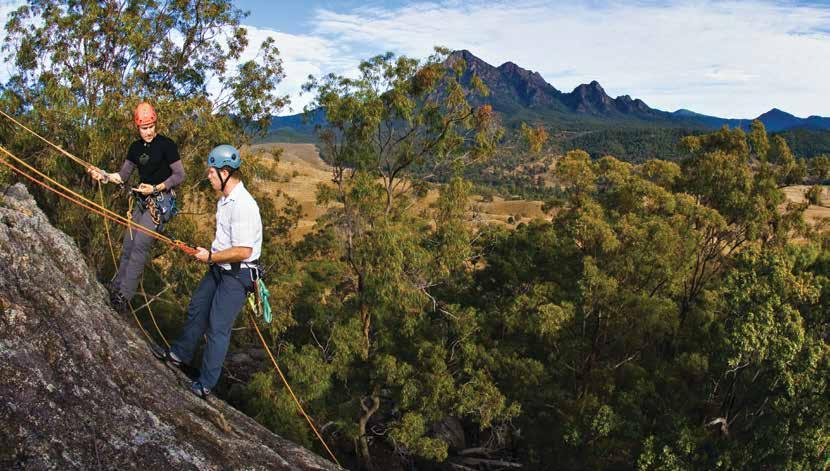
4 minute read
GLOSSARY OF TERMS
BACK ON TRACK - A prioritisation of SEQ region fauna and flora species for recovery actions and threat abatement.
BIODIVERSITY (BIOLOGICAL DIVERSITY) - The different communities, native plants, animals and micro-organisms, the genes they contain and the ecosystems they form.
BUSHLAND - Areas of relatively mature native vegetation remaining in the landscape. Could be preeuropean or mature regrowth. This includes remnant and regrowth vegetation.
CATCHMENT - The entire geographic area drained by a river and its tributaries.
CLIMATE CHANGE/FUTURE CLIMATE CHANGE
- A range of changes to local climate over the next 70 years based on the current unprecedented rise in CO2 in the atmosphere. Such a drastic change is forecast to bring on an accelerated greenhouse effect affecting the whole world climate.
CONSERVATION - The retention of current levels of biodiversity.
DISTURBANCE - Accelerated change caused by human activity or extreme natural events.
ECOLOGICAL SUSTAINABILITY - is a balance that integrates:
(a) Protection of ecological processes and natural systems at local, regional, State and wider levels; and
(b) economic development; and
(c) maintenance of the cultural, economic, physical and social wellbeing of people and communities.
(Queensland Government, 2009)
ECOSYSTEM - A community of organisms interacting with one another and their environment.
ECOSYSTEM SERVICES - Services provided by functioning ecosystems that are essential to human survival (e.g. provision of clean air and water).
ECOTOURISM- Ecologically sustainable tourism with a primary focus on experiencing natural areas that fosters environmental and cultural understanding, appreciation and conservation.
FAUNA - Animals
FLORA - Plants
HABITAT - The physical location of an organism in the environment, the type of environment, vegetation and climate inhabited by an organism.
HABITAT FRAGMENTATION - Habitat becomes isolated from other habitat due to separation by human activities including development and land clearing leading to loss of ecological function.
MONTANE - This ecosystem is characterised by low stunted heath like vegetation growing in mountainous areas. Other characteristics include lack of soil nutrients, hard rock and tough growing conditions.
NON-REMNANT VEGETATION - All vegetation that is not mapped within the Vegetation Management Act (1999) as remnant vegetation or regrowth vegetation.
NON VASCULAR - Non-vascular plants are plants without a vascular system (xylem and phloem). Although non-vascular plants lack these particular tissues, many possess simpler tissues that are specialised for internal transport of water.
POORLY CONSERVED - Less than 4% of the preclearing extent is represented in protected areas.
PRECAUTIONARY PRINCIPLE - An approach to risk management states that if an action or policy has a suspected risk of causing harm to the public or to the environment, in the absence of scientific consensus that the action or policy is not harmful, the burden of proof that it is not harmful falls on those taking an action.
RAMSAR CONVENTION - The Convention on Wetlands of International Importance, called the Ramsar Convention, is an intergovernmental treaty that provides the framework for national action and international cooperation for the conservation and wise use of wetlands and their resources.
RARE AND THREATENED - A general term to describe all species that are categorised for likelihood of extinction as other than common or "least concern". Includes "near threatened", "vulnerable" and "endangered".
REFUGIA - Areas in the landscape that are buffered from extreme weather by features such as dense leaf cover, hills and gullies. Refugia are areas which will face the least long term change in climate and allow for plants and animals to move between areas as these changes occur. It is an area which is stable, accessible and large enough to sustain viable populations of the species residing within it. (Reside Et al, 2013).
REGIONAL ECOSYSTEMS - Vegetation communities in a bioregion that are consistently associated with a particular combination of geology, landform and soil.
REMNANT VEGETATION - Vegetation defined as remnant as per the Vegetation Management Act (1999).
RIVERINE - Associated with the banks of a freshwater watercourse (creeks, rivers, pond or lake).
SALINITY - The increased accumulation of excessive salts in land and water at sufficient levels to impact on humans and natural assets (plants, animals, aquatic ecosystems, water supplies, agriculture or infrastructure.
SEQ BIOREGION - One of the 89 large geographically distinct bioregions in Australia based on common climate, geology, landform, native vegetation and species information.
THREATENED SPECIES - Includes Endangered and Vulnerable under the Nature Conservation Act 1992. Species identified as critically endangered, endangered or vulnerable (IUCN categories International Union for the Conservation of Nature and Natural Resources) in the Environmental Protection Agency’s Back on Track species prioritisation framework.
VASCULAR - A large group of plants that are defined as those land plants that have lignified tissues (the xylem) for conducting water and minerals throughout the plant. They also have a specialised non-lignified tissue (the phloem) to conduct products of photosynthesis.
Scenic Rim Regional Council | Biodiversity Strategy | Page 41







